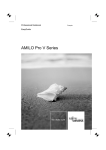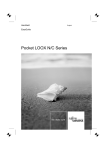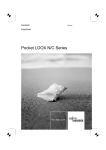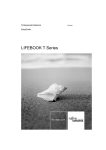Download Fujitsu Siemens Computers V2020 User's Manual
Transcript
Professional Notebook
EasyGuide
AMILO Pro V2020
English
Are there ...
... any technical problems or other questions which you would like to be clarified?
Please contact:
●
Our Hotline/Help Desk
(see the included Help Desk list or go to: http://www.fujitsu-siemens.com/support/helpdesk.html)
●
your sales partner
●
your sales outlet
Additional information is provided on the Help Desk list and in the "Warranty" manual (the
"Warranty" manual is included on the "Drivers & Utilities" CD provided).
The latest information on our products, tips, updates, etc., can be found on the internet under:
http://www.fujitsu-siemens.com
This manual was produced by
cognitas. Gesellschaft für Technik-Dokumentation mbH – www.cognitas.de
Published by
Fujitsu Siemens Computers GmbH
Order No.: A26391-V2020-Z120-1-7619
Edition 1
AG 0105
01/05
Introduction
Index
Notebook views
AMILO Pro V2020
Important notes
Using your notebook for
the first time
Using your notebook
Operating manual
Security functions
Connecting external
devices
Settings in BIOS Setup
Utility
Troubleshooting and tips
Technical data
January 2005 edition
Microsoft, MS, MS-DOS, Windows, and Windows NT are registered trademarks of Microsoft
Corporation.
VESA and DPMS are trademarks of Video Electronics Standards Association.
PS/2 is a registered trademark of International Business Machines, Inc.
Pentium is a registered trademark of Intel Corporation, USA.
Acrobat Reader is a trademark of Adobe Systems Incorporated.
MultiMediaCard is a registered trademark of Infineon Technologies AG
Sony and Memory Stick are registered trademarks of Sony Electronics, Inc.
All other trademarks referenced are trademarks or registered trademarks of their respective
owners, whose protected rights are acknowledged.
Copyright © Fujitsu Siemens Computers GmbH 2005
All rights, including rights of translation, reproduction by printing, copying or similar methods,
in part or in whole, are reserved.
Offenders will be liable for damages.
All rights, including rights created by patent grant or registration of a utility model or design,
are reserved.
Delivery subject to availability. Right of technical modification reserved.
Contents
Innovative technology ... .................................................................................................................1
Notational conventions ......................................................................................................................2
Notebook views ...............................................................................................................................3
Opened Notebook......................................................................................................................3
Front ..........................................................................................................................................4
Back panel.................................................................................................................................4
Right side panel .........................................................................................................................4
Left side panel ...........................................................................................................................5
Under side .................................................................................................................................5
Important notes ...............................................................................................................................7
Safety notes ......................................................................................................................................7
Notes on installing and removing boards and components ........................................................8
Manufacturer’s notes .........................................................................................................................9
Declarations of Conformity.........................................................................................................9
Copyright-protected technology .................................................................................................9
Energy saving ............................................................................................................................9
Recycling and disposal ......................................................................................................................9
CE marking......................................................................................................................................10
Battery storage ................................................................................................................................10
Travelling with your notebook ..........................................................................................................11
Before you travel......................................................................................................................11
Transporting the notebook .......................................................................................................11
Cleaning the notebook.....................................................................................................................12
Using your notebook for the first time .........................................................................................13
Unpacking and checking your notebook ..........................................................................................13
Selecting a location .........................................................................................................................13
Connecting the power adapter .........................................................................................................14
Using your notebook .....................................................................................................................15
Switching the notebook on and off ...................................................................................................15
Switching on the notebook.......................................................................................................15
Switching off the notebook.......................................................................................................15
Status indicators ..............................................................................................................................16
Keyboard .........................................................................................................................................17
Numeric keypad.......................................................................................................................18
Key combinations ....................................................................................................................19
Easy Launch keys ...........................................................................................................................20
Processor fan controlling .................................................................................................................20
Touchpad and touchpad buttons......................................................................................................21
LCD screen .....................................................................................................................................22
Information on LCD monitor.....................................................................................................22
Monitor settings .......................................................................................................................23
Battery.............................................................................................................................................23
Charging, caring for and maintaining the battery......................................................................23
Removing and installing the battery .........................................................................................24
Using the power-management features ...........................................................................................24
PC cards..........................................................................................................................................25
Installing a PC card..................................................................................................................25
Removing a PC card................................................................................................................25
A26391-V2020-Z120-1-7619, edition 1
Contents
Memory card reader........................................................................................................................ 26
Using memory cards ............................................................................................................... 26
Hard disk......................................................................................................................................... 26
Optical drive .................................................................................................................................... 27
Combo drive (CD-RW/DVD).................................................................................................... 28
DVD+RW drive........................................................................................................................ 28
DVD±RW dual drive ................................................................................................................ 28
Handling CD/DVDs.................................................................................................................. 29
Inserting or removing a CD/DVD ............................................................................................. 29
Regional codes for DVD films and DVD players ...................................................................... 30
Adjusting AutoPlay function of optical drive ............................................................................. 30
Audio: Setting volume ..................................................................................................................... 31
Integrated 56k modem .................................................................................................................... 31
Ethernet and LAN............................................................................................................................ 32
Wireless LAN (optional) .................................................................................................................. 32
Switching wireless LAN module on and off.............................................................................. 32
Security functions ......................................................................................................................... 33
Overview of all security functions .................................................................................................... 33
Kensington Lock...................................................................................................................... 33
BIOS password protection....................................................................................................... 33
Brief overview of the security functions ........................................................................................... 34
Using Kensington Lock ................................................................................................................... 34
Configuring password protection in BIOS Setup Utility .................................................................... 34
Protecting BIOS Setup Utility (supervisor password) ............................................................... 34
Password protection of operating system ................................................................................ 36
Connecting external devices........................................................................................................ 37
Connecting an external monitor....................................................................................................... 37
Connecting USB devices................................................................................................................. 38
Connecting external audio devices.................................................................................................. 39
Connecting an external device to S-Video Out ................................................................................ 39
Connecting FireWire devices .......................................................................................................... 39
Settings in BIOS Setup Utility ...................................................................................................... 41
Start BIOS Setup Utility................................................................................................................... 41
Operating BIOS Setup Utility........................................................................................................... 42
Exiting BIOS Setup Utility................................................................................................................ 42
Troubleshooting and tips ............................................................................................................. 43
Reinstalling Windows XP ........................................................................................................ 43
The notebook's date or time is incorrect.................................................................................. 43
The LCD screen of the notebook remains blank...................................................................... 44
The LCD screen is difficult to read .......................................................................................... 44
The external monitor stays blank............................................................................................. 44
The external monitor is blank or the image is unstable............................................................ 45
The notebook cannot be started.............................................................................................. 45
The notebook stops working.................................................................................................... 45
The printer does not print ........................................................................................................ 46
Acoustic warnings ................................................................................................................... 46
Technical data ............................................................................................................................... 47
Power adapter 65 W ....................................................................................................................... 48
Index .............................................................................................................................................. 49
A26391-V2020-Z120-1-7619, edition 1
Innovative technology ...
and ergonomic design make your AMILO Pro the ideal easy to use and reliable notebook.
Your notebook is available in several different versions. Most of the sections in this manual apply to
all models - any differences are pointed out separately. Some of the illustrations and features in this
manual may differ from your model and are for guidance only.
Your operating system (e.g. Microsoft Windows XP) has already been preinstalled and optimally
configured so that you can be up and running from the moment you switch on your AMILO Pro for
the first time.
Your notebook features the very latest technology so that you get the best performance from your
computing experience. Depending on which model you own, you have access to:
●
Up to 1 Gbyte Mbyte of main memory (RAM)
●
A DVD+RW, or a DVD±RW dual drive, or a CDRW / DVD combo drive to watch DVD movies
and record your own disks
●
S-Video out for connecting your notebook to your television
●
An IEEE 1394 (FireWire) connection for high speed devices such as digital camcorders
●
Three USB ports which provide easy expansion with webcams, game pads, printers and more
●
An internal modem for connecting to the internet
●
A PC card slot (CardBus or PCMIA) for using one type I or type II PC card
●
An onboard sound card and stereo speakers for your audio enjoyment.
You can even connect headphones, a microphone and external speakers for even better
performance.
With the user-friendly BIOS Setup Utility you can control the hardware of your notebook and protect
your system better against unauthorised access by using the powerful password properties.
This operating manual tells you how to put your AMILO Pro into operation, and how to operate it in
daily use.
Further information about your AMILO Pro can be found:
●
in the manuals "Safety" and ”Warranty"
●
in the wireless LAN software documentation (PDF file on the "Driver & Utilities" CD)
●
in your operating system documentation
●
in the information files (e.g. *.TXT, *.DOC, *.WRI, *.HLP, *.PDF)
A26391-V2020-Z120-1-7619, edition 1
1
Innovative technology ...
Notational conventions
The following symbols are used in this manual:
!
Indicates information which is important for your health or for preventing
physical damage. Failure to follow the instructions may lead to loss of data,
invalidate your warranty, destroy the notebook, or endanger your life.
i
Indicates important information which is required to use the system properly.
►
Text which follows this symbol describes activities that must be performed in the
order shown.
This font
indicates screen outputs.
This font
indicates programme names, commands, or menu items.
"Quotation marks" indicate names of chapters, hard disks, CDs, DVDs, and terms that are being
emphasised.
2
A26391-V2020-Z120-1-7619, edition 1
Notebook views
This chapter presents the individual hardware components of your notebook. You can obtain an
overview of the displays and connections of the notebook. Please familiarise yourself with these
components before you start to work with your notebook.
Opened Notebook
1=
2=
3=
4=
5=
LCD screen
Easy Launch keys
processor fan controlling
Built-in microphone
ON/OFF switch of the
Notebook
6 = Touchpad
7 = Touchpad scroll bar
8 = Touchpad buttons
9 = Status indicators
10 = Built-in loudspeakers
4
1
2
3
5
10
6
7
9
8
A26391-V2020-Z120-1-7619, edition 1
3
Notebook views
Front
12
11
11 = Memory card slot
12 = On/Off switch for Wireless LAN
Back panel
13
14
13 = Monitor port
14 = Kensington Lock device
Right side panel
15
15 =
16 =
17 =
18 =
19 =
4
PC card slot
PC card eject button
Headphones port
Audio connector
Microphone jack
16
17
18
19
20
20 =
21 =
22 =
23 =
21
22
23
FireWire port
USB ports
DC jack (DC IN)
S-Video out
A26391-V2020-Z120-1-7619, edition 1
Notebook views
Left side panel
24
25
26
27 28
24 = LAN port
25 = Modem port
26 = Optical drive
27 = Insert/Eject button
28 = Opening for manual ejection
Under side
29
30
A26391-V2020-Z120-1-7619, edition 1
29 = Battery compartment
30 = Battery release latch
5
Important notes
Here you will find essential safety information regarding your notebook. In addition, the
manufacturer's notes contain helpful information about your notebook.
Safety notes
!
Pay attention to the information provided in the "Safety" manual and in the following
security notes.
Observe the sections in the manual marked with the symbol on the left.
●
When connecting and disconnecting cables, observe the relevant notes in this operating
manual.
●
Only use batteries designed for this notebook.
Do not store batteries for longer periods in the notebook.
Take care not to drop the batteries or otherwise damage their casing (fire risk).
If the rechargeable batteries develop a fault please stop using them immediately.
Do not touch the contacts of the batteries.
Never interconnect the positive and negative terminals of a battery.
Batteries are harmful to the environment. You should dispose of them following guidance from your
local District Council.
●
There is a lithium battery (button cell) installed in your notebook. Please note:
The battery should only be replaced by an authorised technician. Incorrect handling may lead
to a risk of explosion.
Only use batteries approved by Fujitsu Siemens Computers.
Batteries are harmful to the environment. You should dispose of the lithium battery following
guidance from your local District Council.
●
All batteries containing pollutants are marked with one of the two symbols below (crossed-out
garbage can).
In addition, the marking is provided with the chemical symbol of the heavy metal decisive for
the classification as a pollutant.
Cd Cadmium
Hg Mercury
Pb Lead
A26391-V2020-Z120-1-7619, edition 1
7
Important notes
●
Read the information on the ambient conditions in the chapter "Technical data" and the
chapter "Using your notebook for the first time" before putting your notebook into operation and
switching it on for the first time.
●
When cleaning the device, please observe the relevant notes in the "Cleaning the notebook"
paragraph.
●
Keep this operating manual together with your notebook.
If you pass on the notebook to a third party, you should also pass on the operating manual.
●
If you have a notebook with wireless LAN, you must also observe the additional safety
precautions for devices with wireless LAN in the "Safety" manual.
This notebook complies with the relevant safety regulations for data processing equipment. If you
have questions about using your notebook in a particular area, please contact your sales outlet or
our hotline/help desk.
Notes on installing and removing boards and components
!
Only qualified technicians should repair your notebook. Unqualified users who open the
notebook’s case expose themselves to electric shock and fire hazards. It will also
invalidate your warranty.
●
Switch the notebook off and pull the power plug out of the mains socket.
●
Remove the battery.
●
Take care when you use the locking mechanisms on the battery and any other component.
●
Never use sharp objects such as screwdrivers, scissors or knives as leverage to remove
covers.
Boards with electrostatic sensitive devices (ESD) are identifiable by the label shown.
When you handle boards fitted with ESDs, you must, under all circumstances, observe the following
points:
●
●
●
You must statically discharge yourself before working with boards (e.g. by touching a grounded
object).
The equipment and tools you use must be free of static charges.
Remove the power plug from the mains supply before inserting or removing boards containing
ESDs.
Always hold boards with ESDs by their edges.
Never touch pins or conductors on boards fitted with ESDs.
8
A26391-V2020-Z120-1-7619, edition 1
●
●
Important notes
Manufacturer’s notes
Declarations of Conformity
The "Declarations of Conformity" concerning the AMILO Pro can be found at our internet address:
http://www.driver-cd.com.
Hereby, Fujitsu Siemens Computers, declares that the AMILO Pro is in compliance with the
essential requirements and other relevant provisions of Directive 1999/5/EC.
Copyright-protected technology
This product incorporates copyright protection technology that is protected by method claims of
certain U. S. patents and other intellectual property rights owned by Macrovision Corporation and
other rights owners. Use of this copyright protection technology must be authorised by Macrovision
Corporation, and is intended for home and other limited viewing uses only unless otherwise
authorised by Macrovision Corporation. Reverse engineering or disassembly is prohibited.
Energy saving
If you will not be using your notebook, switch it off.
Make use of the device's energy saving functions (see "Using your notebook"). The notebook uses
less power when the power management features are enabled. You will then be able to work for
longer before having to recharge the battery.
Energy saving under Windows
If a monitor with energy saving features is connected to your notebook, you can use the Screen Saver
tab to activate the energy saving features of the monitor. Select a screen saver in the menu Start Control Panel - Appearance and Themes - Display - Screen Saver.
You may set further energy saving functions in the menu Start - Control Panel - Performance and
Maintenance - Power Options.
Recycling and disposal
Do not throw batteries or accumulators into the household waste.
Our devices are mostly produced of materials that can be turned over for proper recycling. The
device may be taken back after use to be recycled, provided that it is returned in a condition that is
the result of normal use. Any components not reclaimed will be disposed of in an environmentally
acceptable manner. To dispose of devices please contact your local District Council for advice.
Further information about country-specific disposal and recycling possibilities can be found on the
following website www.fujitsu-siemens.com/recycling.
If you have any questions on disposal, please contact your local office or our Help Desk.
A26391-V2020-Z120-1-7619, edition 1
9
Important notes
CE marking
CE marking for devices without wireless LAN
The shipped version of this device complies with the requirements of the EEC
directives 89/336/EEC "Electromagnetic compatibility" and 73/23/EEC "Low
voltage directive".
CE marking for devices with wireless LAN
This equipment complies with the requirements of Directive 1999/5/EC of the
European Parliament and Commission from 9 March, 1999 governing Radio and
Telecommunications Equipment and mutual recognition of conformity.
This device is approved for use in Belgium, Denmark, Germany, Finland,
Greece, Great Britain, Ireland, Italy, Luxembourg, the Netherlands, Austria,
Portugal, Sweden, Switzerland, Spain, Iceland, Liechtenstein and Norway.
Contact the corresponding government office of the respective country for
current information on possible operating restrictions. If your country is not
included in the list, then please contact the corresponding supervisory authority
as to whether the use of this product is permitted in your country.
Restrictions
●
France
Limited frequency range: only the channels 10 to 13 (2457 MHz or
2472 MHz) may be used in France. It is prohibited to use the device
outdoors.
●
Italy
A ministerial permit is also required for use indoors. Please contact the
seller concerning the required procedure. It is prohibited to use the device
outdoors.
●
Netherlands
A licence is required for use outdoors. Please contact the seller
concerning the required procedure.
Battery storage
i
If you do not use the batteries for long periods, remove them from the notebook. Never
store the batteries in the unit.
Store the battery when it is half full or two-thirds full. The battery should be stored in a dry area at a
temperature between 0°C and +30°C. The lower the temperature at which the batteries are stored,
the lower is the rate of self-discharge.
10
A26391-V2020-Z120-1-7619, edition 1
Important notes
Travelling with your notebook
Please follow these guidelines when travelling with your notebook.
Before you travel
●
Back up important data stored on your hard disk.
●
Turn off the wireless module before you travel. This will help keep your notebook secure, and
also prevent it from affecting sensitive equipment in hospitals, airports and other areas.
●
If you wish to use your notebook during a flight, first check with the flight attendants if it is OK
to do so.
●
If you are travelling abroad, check that the mains adapter can be operated with the local mains
voltage. If this is not the case, obtain the appropriate power adapter for your notebook.
Do not use any other voltage converter!
i
If you travel in another country, check whether the local power supply and the
specifications of the power cable are compatible. If this is not the case, buy a power cable
that matches the local conditions. Do not use a connection adapter for electrical devices
to connect the notebook.
Your modem may not be fully compatible with the telephone system in the country you
are visiting. This may result in poor performance, or the modem will not work at all.
Transporting the notebook
●
Remove all disks (e.g. CD, DVD) from the drives.
●
Switch the notebook off.
●
Unplug the power adapter and all external devices from the power socket.
●
Disconnect the power adapter cable and the data cables for all external devices.
●
Close the LCD screen so that it locks into place.
●
To protect against damaging jolts and bumps, use a notebook carrying case to transport your
notebook.
●
Protect the notebook from severe shocks and extreme temperatures (e.g. direct sunlight in a
car).
A26391-V2020-Z120-1-7619, edition 1
11
Important notes
Cleaning the notebook
►
Switch the notebook off.
►
Unplug the power adapter from the mains outlet.
►
Remove the battery.
!
Do not clean any interior parts yourself; leave this job to a service technician.
Only use cleaning products designed for computers. Normal household cleaners and
polishes can damage the markings on the keyboard and the device, the paintwork or the
notebook itself.
Ensure that no liquid enters the notebook.
Wipe the casing with a dry cloth.
If particularly dirty, use a cloth which has been moistened in mild domestic detergent and then
carefully wrung out.
To clean the keyboard and the touchpad, you can use disinfectant wipes.
12
A26391-V2020-Z120-1-7619, edition 1
Using your notebook for the first time
!
Please read the "Important notes" chapter.
Before you can use your notebook for the first time you need to charge the battery and install the
supplied software. Your operating system (e.g.Windows XP) and the hardware drivers have been
preinstalled for you.
Upon delivery, the battery can be found in the battery compartment. The battery must be charged if
you want to operate your notebook with the battery.
When not plugged into a mains outlet, the notebook runs on its built-in battery. You can increase the
battery's life by enabling the system's energy saving functions.
When you use your notebook in your home or office, we recommend you use the mains adapter
instead of the battery.
Please see the "Connecting external devices" chapter for instructions on how to connect devices
such as a mouse and a printer to the notebook.
Unpacking and checking your notebook
►
Unpack all the individual parts.
►
Check your notebook for damage incurred during transportation.
!
i
Should you discover damages incurred during transportation, notify your local sales
outlet immediately!
We recommend that you keep the original packaging material. You may need the
packaging in the future if you need to transport your device.
Selecting a location
Select a suitable location for the notebook before setting it up. Consider the following points when
looking for a location:
●
Do not put your notebook on a soft surface such as a carpet, a rug, or your knee. This can
block the air vents and cause overheating and damage.
●
Place the notebook on a stable, flat, nonslippery surface. Please note that the rubber feet may
mark certain types of surfaces.
●
The notebook and the power adapter should be at least 200 mm apart.
●
Keep other objects 100 mm away from the notebook and its power adapter to ensure adequate
ventilation.
●
Never cover the fan intake or exhaust openings of the notebook or the power adapter.
●
Do not expose the notebook to extreme environmental conditions.
Protect the notebook from dust, humidity, and heat.
A26391-V2020-Z120-1-7619, edition 1
13
Using your notebook for the first time
Connecting the power adapter
!
Please take note of the information in the section "Safety notes".
The power cable supplied conforms to the requirements of the country in which you
purchased your notebook. Make sure that the power cable is approved for use in the
country in which you intend to use it.
The mains adapter's AC cable should only be connected to a mains socket if the
notebook is connected to the mains adapter.
Do not use the power adapter for other notebooks or devices.
Do not use a power adapter that is not specially intended for this notebook.
1
3
2
►
Connect the power adapter cable to the DC jack (DC IN) of the notebook (see chapter
"Notebook views", Number 22).
►
Connect the power cable to the mains adapter.
►
Plug the power cable into a mains outlet.
The battery indicator
14
flashes. The battery will charge.
A26391-V2020-Z120-1-7619, edition 1
Using your notebook
This chapter describes the basics for operating your notebook.
Please see the "Connecting external devices" chapter for instructions on how to connect devices
such as a mouse and a printer to the notebook.
!
Please take note of the information in the "Important notes" chapter.
Switching the notebook on and off
Switching on the notebook
►
Slide the release (on front of notebook) to the right and fold up the LCD screen.
►
Press the ON/OFF switch (1) to switch the notebook on.
Switching off the notebook
►
Shut down the operating system properly (e. g. Windows XP by clicking Start then Turn off
Computer).
►
If the notebook is not switched off automatically, press the ON/OFF switch for approx. five
seconds.
►
Close the LCD screen so that it locks into place.
A26391-V2020-Z120-1-7619, edition 1
15
Using your notebook
Status indicators
The status indicators (see chapter "Notebook views", Number 9) provide information on the states of
the power supply, the drives and the keyboard functions.
Power-on/battery indicator
●
●
The indicator lights up green when the notebook is switched on and when the
battery is fully charged.
The indicator flashes yellow while the battery is being charged.
This indicator is also visible with the notebook closed.
Drive indicator
The indicator flashes when the hard drive or the CD/DVD drive is being accessed.
1
A
Num Lock indicator
The indicator lights up when the Num key has been pressed. The numbers on the
upper right on keys in the integrated numeric keypad are enabled.
Caps Lock indicator
The indicator lights up when the caps lock key has been pressed. All the characters you
type appear in uppercase. In the case of overlay keys, the character printed on the upper
left of the key appears when that key is pressed.
Wireless LAN indicator (optional)
The indicator lights up when wireless LAN is activated.
The indicator does not light when wireless LAN is deactivated.
Scroll indicator (Scroll Lock)
The indicator lights up when the keys Fn + Scroll Lock have been pressed. The effect
this key has varies from programme to programme.
Energy-saving mode indicator
The indicator lights green when whisper mode is active (see the "Processor fan
controlling" chapter).
If you device is in standby mode at this moment, the light flashes green.
This indicator is also visible with the notebook closed.
16
A26391-V2020-Z120-1-7619, edition 1
Using your notebook
Keyboard
i
The keyboard of your notebook is subject to continuous wear due to normal use. The
keyboard markings are subjected to particularly high loads. The keyboard markings can
wear off in the course of using the notebook.
The keyboard has been designed to provide all the functions of an enhanced keyboard. Some
enhanced keyboard functions are mapped with key combinations.
The following description of keys refers to Windows. Additional functions supported by the keys are
described in the relevant manuals supplied with your application programmes.
The figure below shows how to access the different characters on keys with overlaid functions. The
example applies when the CapsLK indicator is not lit.
Fn
/
7
7
{
/
7
7
{
/
7
7
{
/
7
7
{
Num
Alt Gr
/
7
7
{
Example from a German keyboard
Backspace key
The Backspace key deletes the character to the left of the cursor.
Tab key
The Tab key moves the cursor to the next tab stop.
Enter key (return)
The enter key terminates a command line. The command you have entered is
executed when you press this key.
A26391-V2020-Z120-1-7619, edition 1
17
Using your notebook
Caps Lock key
The Caps Lock key activates uppercase mode (CapsLK indicator lit). The Caps Lock
function causes all the characters you type to appear in uppercase. In the case of
overlay keys, the character printed on the upper left of the key appears when that key
is pressed.
To cancel the Caps Lock function, simply press the Caps Lock key again.
Caps Lock
Shift key
The Shift key causes uppercase characters to appear. In the case of overlay keys,
the character printed on the upper left of the key appears when that key is pressed.
Fn key
The Fn key enables the special functions indicated on overlay keys (see "Key
combinations").
If the external keyboard does not feature a Fn key, you can simultaneously press
the Ctrl + Alt keys instead.
Fn
Cursor keys
The cursor keys move the cursor in the direction of the arrow, i.e. up, down, left, or
right.
Pause key
The Pause key temporarily suspends display output. Output will resume when you
press any other key.
Pause
Break
Start key
The Start key invokes the Windows Start menu.
Menu key
The Menu key invokes the menu for the selected item.
Numeric keypad
&
*
8
7
U
1
)
0
I
J
7
O
K
M
1=
2=
(
9
P
<
,
2
>
.
.
?
/
*
9
4
:
;
L
8
5
1
2
0
–
6
+
3
.
/
Characters enabled when NumLK indicator is not lit (see the "Status indicators" section).
Characters enabled when NumLK indicator is lit (see the "Status indicators" section).
When the numeric keypad is turned on (NumLK is indicated) you can output the symbols on the
upper right on the keys.
18
A26391-V2020-Z120-1-7619, edition 1
Using your notebook
Key combinations
The following description of key combinations refers to functions when using Microsoft Windows.
Some of the following key combinations may not function in other operating systems and with some
device drivers.
Other key combinations are described in the relevant manuals supplied with your application
programmes.
Key combinations are performed as follows:
►
Press and hold the first key in the combination.
►
While holding the first key down, press the other key or keys in the combination.
i
If the external keyboard does not feature a Fn key, you can simultaneously press
the Ctrl + Alt keys instead.
Fn
+
F1
Fn
+
F3
Fn
+
F4
Enabling Suspend mode
This key combination switches the notebook into the Suspend mode.
Switching the loudspeakers on/off
This key combination switches your notebook's loudspeaker off and on.
Switching between internal and external screen
If an external monitor is connected, the monitor on which the output is to be
displayed can be selected with this key combination.
You can opt to use:
●
●
●
Fn
+
F5
Fn
+
F6
Fn
+
F7
Fn
+
F8
just the notebook's LCD screen
just the external monitor
both the LCD screen and the external monitor.
Increasing the volume
This key combination raises the volume of the integrated loudspeakers.
Reducing the volume
This key combination reduces the volume of the integrated loudspeakers.
Increasing screen brightness
This key combination increases screen brightness.
Decreasing screen brightness
This key combination decreases screen brightness.
A26391-V2020-Z120-1-7619, edition 1
19
Using your notebook
Switching between open applications
Alt
+
Ctrl
+
With this key combination you can switch between several open
applications.
Carrying out a warm boot
Alt
+ Del
This key combination triggers a reset and warm-boots the
notebook. First hold down the Ctrl and Alt key, and then press
the Del key. First the Task Manager is displayed. Then you
must press all three keys again to re-boot.
Backtab (Shift+Tab)
+
i
This key combination moves the cursor back to the previous
tabular stop.
Key combinations with the Windows keys are contained in the manual for your operating
system.
Easy Launch keys
Your notebook is equipped with two Easy Launch keys (see chapter "Notebook views", Number 2).
You can start the following applications by pressing a single key.
E-mail
Use this button to start the standard e-mail programme for your system.
Internet
With this button you can start the standard internet browser for your system.
Processor fan controlling
Whisper mode
This key reduces the speed of the fan.
i
When whisper mode is active, the processor works at reduced speed.
If you want the notebook to deliver full performance, deactivate whisper mode.
The status indicator
lights green when whisper mode is active. If you device is in
standby mode at this moment, the light flashes green.
20
A26391-V2020-Z120-1-7619, edition 1
Using your notebook
Touchpad and touchpad buttons
!
Keep the touchpad clean. Protect it from dirt, liquids, and grease.
Do not use the touchpad if your fingers are dirty.
Do not rest heavy objects (e.g. books) on the touchpad or the touchpad buttons.
The touchpad (see chapter "Notebook views", Number 6) enables you to move the mouse pointer
on the screen.
You can use the touchpad to scroll. The scroll bar on the right edge of the touchpad is marked with
arrows (see chapter "Notebook views" Number 7).
The touchpad buttons (see chapter "Notebook views", Number 8) allow the selection and execution
of commands. They correspond to the buttons on a conventional mouse.
Moving the pointer
►
Move your finger on the touchpad.
The pointer will move accordingly.
Selecting an item
►
Move the pointer to the item you wish to select.
►
Tap the touchpad once or press the left button once.
The item will be selected.
Executing a command
►
Move the pointer to the field you wish to select.
►
Tap the touchpad twice or press the left button twice.
The command will be executed.
Dragging an object
►
Select the desired object.
►
Press and hold the left button and drag the object to the desired position with the finger on the
touchpad.
The item will be moved.
Scrolling with the touchpad scroll bar
►
Move your finger upwards or downwards on the scroll bar at the right edge of the touchpad.
The display area moves up or down.
A26391-V2020-Z120-1-7619, edition 1
21
Using your notebook
LCD screen
Information on LCD monitor
High-quality TFT displays are installed in notebooks from Fujitsu Siemens Computers GmbH. For
technical reasons, TFT monitors are manufactured for a specific resolution. An optimal, clear picture
can only be ensured in the resolution intended for the respective TFT monitor. A monitor resolution
which differs from the specification can result in an unclear picture.
The monitor resolution is understood to be the number of horizontal and vertical pixels (i.e. picture
elements) which make up the monitor display. For example, "UXGA" stands for 1600 x 1200 pixels.
Each pixel consists of three so-called subpixels of the colours red, green and blue. As a result, a
UXGA monitor consists of 1600 x 1200 x 3 = 5.760.000 subpixels.
Frequently used monitor resolutions
Number of pixels
XGA
1024 x 768
WXGA
1280 x 800
SXGA
1280 x 1024
SXGA+
1400 x 1050
UXGA
1600 x 1200
The screen resolution of the LCD monitor of your notebook is optimally set at the factory.
Permanently unlit or lit pixels
The standard of production techniques today cannot guarantee an absolutely fault-free screen
display. A few isolated constant lit or unlit pixels may be present. The maximum permitted number
of pixels faults is stipulated in the stringent international standard ISO 13406-2 (Class II).
Example:
A 15" LCD screen monitor with a resolution of 1024 x 768 has 1024 x 768 = 786432 pixels.
Each pixel consists of three subpixels (red, green and blue), so there are almost 2,4 million
subpixels in total. According to ISO 13406-2 (Class II), a maximum of 4 pixels and 5 subpixels
may be defective, i. e. a total of 17 faulted subpixels. That is approx. 0.0002 % of the entire
subpixel!
Background lighting
TFT screens are operated with background lighting. The luminosity of the background lighting can
decrease during the period of use of the notebook. However, you can set the brightness of your
monitor individually.
22
A26391-V2020-Z120-1-7619, edition 1
Using your notebook
Monitor settings
Setting the desktop area
The screen resolution of the LCD monitor of your notebook is optimally set at the factory.
Changing the font size
Under Start - Control Panel - Appearance and Themes - Display - Advanced you can choose between a
larger and a smaller font in the Font size field.
Synchronising the display on the LCD screen and an external monitor
Your notebook supports the simultaneous display on the LCD screen and an external monitor.
Pressing the key combination Fn + F4 switches between LCD only, external monitor and LCD
and external monitor only. The last setting is useful if you would like high resolution and refresh rate
on an external monitor.
Battery
The battery is one of the most important components of your notebook. When not plugged into a
mains outlet, the notebook runs on its built-in battery. You can increase the life of the battery by
caring for the battery properly. The average battery life is around 500 charge/discharge cycles.
You can extend the battery life by taking advantage of the available energy saving functions.
!
Only use batteries approved by Fujitsu Siemens Computers for your notebook.
Take care not to drop the batteries or otherwise damage their casing (fire risk).
If the rechargeable batteries develop a fault please stop using them immediately.
Do not touch the contacts of the batteries.
Never interconnect the positive and negative terminals of a battery.
Batteries are harmful to the environment. You should dispose of them following guidance from
your local District Council.
Observe the information on battery storage in the "Important notes" chapter.
Charging, caring for and maintaining the battery
The notebook battery can only be charged, when the ambient temperature is between 5 °C and
max. 35 °C.
You can charge the battery by connecting the notebook to the power adapter (see "Connecting the
power adapter").
You can maintain long life from your battery by allowing it to discharge fully before you recharge it
again. To do this, leave your notebook turned on when it is operated with the battery. Once the
battery is running low you will hear a warning alarm. If you do not connect the mains adapter within
five minutes of the warning alarm described above, your notebook will automatically switch off.
Information on the battery charging time is contained in the "Technical data" chapter.
Monitoring the battery charging level
Windows also has a "Battery status meter" in the taskbar for monitoring the battery capacity. When
you place the mouse pointer on the battery symbol, the system displays the battery status.
A26391-V2020-Z120-1-7619, edition 1
23
Using your notebook
Removing and installing the battery
!
Only use batteries approved by Fujitsu Siemens Computers for your notebook.
Never use force when inserting or removing a battery.
Make sure that no foreign bodies get into the battery connections.
Removing battery
►
Switch the notebook off and pull the power plug out of the mains socket.
►
Close the LCD screen so that it locks into place.
►
Disconnect all cables connected to the notebook.
►
Turn your notebook over and place it on a sturdy, flat surface.
►
Push the battery lock (see chapter "Notebook views", Number 30) in the direction of the arrow
and hold it in place.
The arrow is shown on the battery lock.
►
Remove the battery from the battery compartment (see chapter "Notebook views",
Number 29).
Inserting battery
►
Push the battery into the battery compartment until it engages.
►
Close the battery compartment.
Using the power-management features
The notebook uses less power when the power management features are enabled. You will then be
able to work longer when using the battery before having to recharge it.
You can also use energy saving modes such as Standby or Hibernate for times when you are not
using your notebook but want to keep coming back to it.
i
If you are connecting to a network, or the Internet, we advise you to turn off the energy
saving modes as they interrupt your connection.
When you are finished working with your notebook we advise you to come out of an
energy saving mode and then turn off as normal.
Never turn off your notebook while it is in an energy saving mode.
If the notebook is in an energy-saving mode mode:
●
Do not connect any external devices.
●
Do not disconnect any external devices.
●
Do not attempt to switch the notebook on if the built-in battery is flat.
●
Do not add or remove RAM.
●
Do not add or remove a PC card.
When you close the lid, the notebook automatically enters an energy-saving mode.
The energy saving functions can be activated under Start - Control Panel - Performance and
Maintenance - Power Options. Under Windows, Hibernate is activated by default.
24
A26391-V2020-Z120-1-7619, edition 1
Using your notebook
PC cards
A PC card slot (CardBus or PCMIA) enables the notebook to operate one type I or type II PC card.
!
Consult the documentation supplied by the PC card's manufacturer and follow the
instructions provided.
Never use force when inserting or removing a PC card.
Make sure that foreign objects do not fall into the PC card slot.
Installing a PC card
►
Press the eject button (see chapter "Notebook views", Number 16). The placeholder for the PC
card will project further out of the notebook's case.
►
Pull the placeholder for the PC card out of the slot (see chapter "Notebook views",
Number 15).
i
Keep the placeholder for the PC card in a safe place. When you remove the PC card you
should also refit the placeholder for the PC card. Thus you prevent foreign objects from
getting into the PC card slot.
►
Insert the PC card end with the connector contacts into the card slot guide rails
The labelled side of the PC card must face upwards.
►
Gently push the PC card into the slot until you feel it click into place.
i
Consult the documentation supplied with the PC card for information on how to install the
necessary device drivers.
You should also read the help files supplied on CD, the information provided for the
PC card driver or the information provided by the operating system (e. g. Windows XP
Help and Support Center).
You can push the PC card slot eject button into the notebook casing. To do this, press
the eject button until it engages.
Removing a PC card
Use the small PC card icon located in your task bar to stop the card:
►
Click on the
►
Select the PC card you want to stop and remove.
►
Press the Enter key.
symbol in the taskbar with the left mouse button.
Wait for the dialogue box which tells you that it is now safe to remove the PC card.
►
Press the eject button. The PC card will project further out of the notebook's case.
If the eject button is lowered, you must first cause the eject button to release from the
notebook casing. To do this, press the eject button until it releases.
►
Slide the PC card out of the notebook.
►
Insert the placeholder for the PC card into the slot guide.
►
Gently slide the placeholder for the PC card into the slot until you feel it click into place.
A26391-V2020-Z120-1-7619, edition 1
25
Using your notebook
Memory card reader
Your notebook is equipped with a memory card reader. Your memory card reader supports the
following formats:
•
•
•
Secure Digital (SD™ Card)
MultiMediaCard (MMC)
Memory Stick (Sony®)
Using memory cards
i
Please read the documentation supplied with the memory card for any special
instructions.
1=
2=
Label area
Insertion direction
2
1
Inserting memory card
►
Depending on the memory card used, insert the memory card in the upper or lower slot guide
with the connection contacts first (see chapter "Notebook views", Number 11).
►
Carefully push the memory card into the slot.
Removing memory card
►
Pull the memory card out of the slot.
Hard disk
The hard disk is the most important storage medium of your notebook. You can work considerably
faster and more efficiently if you copy applications and files from CDs to your hard disk.
26
A26391-V2020-Z120-1-7619, edition 1
Using your notebook
Optical drive
Your notebook is delivered with an optical drive. Depending on the variant, your notebook is
equipped with a combo drive (CD-RW/DVD), a DVD+RW drive or a DVD±RW dual drive.
Optical drives can either only read or both read and write different CDs or DVDs. The meaning of
the respective CD and DVD types is described in the following:
CD-ROM
Abbreviation for Compact Disc - Read Only Memory. A CD-ROM is an optical data storage device
that can contain a maximum of 700 Mbytes. These data cannot be changed.
CD-R
Abbreviation for Compact Disc Recordable. A CD-R is an optical data storage device that can only
be written with a maximum of 700 Mbytes of data. Then these data cannot be changed, but can be
read as often as desired.
CD-RW
Abbreviation for Compact Disc ReWriteable. A CD-RW is an optical data storage device that can be
written with a maximum of 700 Mbyte of data a virtually unlimited number of times. This means the
data can be deleted and changed.
DVD (DVD-ROM and DVD video)
Abbreviation for Digital Versatile Disc or Digital Video Disc. A DVD is an optical data storage
medium that can contain a maximum of 17 Gbytes of data. These data cannot be changed.
DVD+R/DVD-R
Abbreviation for Digital Versatile Disc Recordable or Digital Video Disc Recordable. A DVD+R or a
DVD-R is an optical data storage device that can only be written once with a maximum of
4.7 Gbytes of data. Then these data cannot be changed, but can be read as often as desired.
i
DVD+R and DVD-R are different standards. DVD+Rs and DVD-Rs can only be written by
drives which support the respective standard.
DVD+RW/DVD-RW
Abbreviation for Digital Versatile Disc or Digital Video Disc ReWriteable. A DVD+RW or a DVD-RW
is an optical data storage device that can be written with a maximum of 4.7 Gbytes of data virtually
an unlimited number of times. This means the data can be deleted and changed.
i
DVD+RW and DVD-RW are different standards. DVD+RWs and DVD-RWs can only be
written by drives which support the respective standard.
A26391-V2020-Z120-1-7619, edition 1
27
Using your notebook
Combo drive (CD-RW/DVD)
!
The combo drive is a Class 1 laser according to IEC 60825-1.
It contains a light emitting diode (LED) which may produce a stronger laser beam than a
Class 1 laser.
It is dangerous to loo directly at this beam.
Therefore, do not remove any drive housing parts.
You can read all CD/DVD types specified above with the combo drive. You can also write CD-Rs
and CD-RWs.
Please ask your local computer store for assistance if you are not sure which CD or DVD type suits
best for your needs, e. g. backing up data, recording films, storing pictures etc..
DVD+RW drive
!
The DVD+RW drive is a Class 1 laser according to IEC 60825-1.
It contains a light emitting diode (LED) which may produce a stronger laser beam than a
Class 1 laser.
It is dangerous to loo directly at this beam.
Therefore, do not remove any drive housing parts.
With the DVD+RW drive you can read all CD/DVD types named above. You can also write CD-R,
CD-RW and DVD+RW.
Please ask your local computer store for assistance if you are not sure which CD or DVD type suits
best for your needs, e. g. backing up data, recording films, storing pictures etc..
DVD±RW dual drive
!
The DVD±RW drive is a Class 1 laser according to IEC 60825-1.
It contains a light emitting diode (LED) which may produce a stronger laser beam than a
Class 1 laser.
It is dangerous to loo directly at this beam.
Therefore, do not remove any drive housing parts.
With the DVD±RW dual drive you can read all CD/DVD types named above. You can also write CDRs, CD-RWs, DVD+Rs, DVD+RWs, DVD-Rs and DVD-RWs.
Please ask your local computer store for assistance if you are not sure which CD or DVD type suits
best for your needs, e. g. backing up data, recording films, storing pictures etc.
28
A26391-V2020-Z120-1-7619, edition 1
Using your notebook
Handling CD/DVDs
!
i
Observe the following guidelines when handling CD/DVDs:
●
Avoid touching the surface of a CD/DVD. Hold CDs/DVDs by their edges!
●
Always store CDs/DVDs in their cases. This will protect CD/DVD from dust,
scratches and other damage.
●
Protect your CDs/DVDs from dust, mechanical vibration and direct sunlight!
●
Avoid storing a CD/DVD in areas subject to high temperatures or humidity.
In order to make use of the full recording speed of your drive, please use disks marked
"Multispeed" or "High Speed"
Use only DVD blanks of the type DVD+RW. Other types of DVD blanks are not supported
by your optical drive.
Inserting or removing a CD/DVD
Your notebook must be switched on.
►
Push the insert/eject button (see chapter "Notebook views", Number 27).
The drive tray will open.
►
Gently pull the drive tray completely out.
►
Place the CD/DVD in the drive tray with the label facing upwards.
or
►
Take out an inserted CD/DVD.
►
Push in the drive tray until you feel it lock into place.
Manual removal (emergency removal)
In the event of a power failure or damage to the drive it may be necessary to manually remove the
CD/DVD.
►
Switch the notebook off.
►
Press a pen or a piece of wire (e.g. a paperclip) firmly into the opening
(see the "Notebook views" chapter, Number 28).
The drive tray is ejected. You can now pull the drive tray out of the drive.
A26391-V2020-Z120-1-7619, edition 1
29
Using your notebook
Regional codes for DVD films and DVD players
DVD films and DVD players (e.g. the DVD drive of your notebook) are always provided with a
regional code. The regional codes of DVD films and DVD players must match so that the DVD film
can be played back.
There are six different regional codes:
●
●
●
Regional code 1: USA and Canada
Regional code 2: Egypt, Europe, Japan, South Africa and the Middle East
Regional code 3: Southeast Asia (including Hong Kong, Indonesia, Philippines, South Korea,
Taiwan)
Regional code 4: Australia, New Zeeland, South Eastern Pacific, Central and South America
and the Caribbean
Regional code 5: Africa (except South Africa), India and the former states of the USSR
Regional code 6: China
●
●
●
The DVD drive of your notebook supports the function RPC-II (Phase II System of Regional
Playback Control). This function permits the final user to change the regional code of the drive up to
five times to play back corresponding DVD films. Then the last regional code selected is retained
and cannot be changed again.
If a DVD film is to be watched in all regions, it has the regional code 0.
i
Before buying a DVD film you should check that the regional code of the DVD film
matches the regional code set for the DVD drive of your notebook.
Adjusting AutoPlay function of optical drive
Windows XP uses AutoPlay technology. This allows you to tell Windows how to use different types
of CD or DVD disks.
You can set the AutoPlay function of the optical drive according to your needs. For example, if you
insert a music CD you can tell Windows XP to open Media Player and start to play it.
Proceed as follows:
►
Click Start and then My Computer.
The My Computer window will appear.
►
Select the CD / DVD icon you want to change and click it with the right-hand mouse or
touchpad button.
A context menu appears.
►
Click on Properties.
►
Click on the AutoPlay tab.
►
Adjust the AutoPlay function to meet your needs.
i
30
Please note that you must select the desired action and confirm it with Apply for each
individual CD/DVD content type.
A26391-V2020-Z120-1-7619, edition 1
Using your notebook
Audio: Setting volume
►
Set the desired volume with the key combination Fn + F5 or Fn + F6 .
or
To adjust the volume use the Windows volume control from the Start menu - Programs Accessories - Multimedia - Volume Control.
►
Integrated 56k modem
The integrated 56k modem supports all data communication applications, such as:
●
Modem operation: High-speed downloads at up to 56,000 bit/s (V.90). Downward-compatible
to V.34 modems.
●
Fax mode: Transmitting and receiving at up to 14,400 bit/s
●
Simple country adaptation with programme
The modem complies with the EU Directive 91/263/EEC (Telecommunications terminal equipment
directive) and has been checked in agreement with the guideline TBR-21.
The modem can be operated in the following countries:
Multifrequency (MFC) dialling
Belgium, Denmark, Germany, Finland, France, Greece, Great Britain, Holland, Ireland, Iceland,
Italy, Luxembourg, Norway, Austria, Portugal, Sweden, Switzerland and Spain.
Pulse dialling:
Belgium, France, Holland and Italy.
Also in: Poland, Slovenia, South Africa and Hungary.
Connecting notebook modem to telephone connection
►
Connect the modem cable supplied to the country-specific telephone adapter.
►
Connect the modem cable to the modem port
of the notebook.
►
Connect the modem cable to your telephone wall socket.
i
(see chapter "Notebook views", Number 25)
Please note that the telephone line is busy and that you cannot use your telephone if the
modem cable is plugged into the telephone wall socket. Pull the modem cable out of the
telephone socket after you have finished your internet session or the fax mode and
reconnect the telephone cable.
A26391-V2020-Z120-1-7619, edition 1
31
Using your notebook
Ethernet and LAN
The internal LAN module of your notebook supports Ethernet-LAN (10/100 Mbps).
►
Connect the LAN cable to the notebook's LAN connector
Number 24).
►
Connect the network cable to your LAN network connector.
(see chapter "Notebook views",
Wireless LAN (optional)
!
The installation of a wireless LAN module not approved by Fujitsu Siemens
Computers GmbH voids the permits (CE!, FCC) issued for this device.
A wireless LAN is integrated in your notebook.
Switching wireless LAN module on and off
1
►
Slide the ON/OFF switch for Wireless LAN (1) into the "ON" position to activate the wireless
LAN module.
The wireless LAN indicator
lights up.
or
►
Slide the ON/OFF switch for Wireless LAN (1) into the "OFF" position to deactivate the
wireless LAN module.
The wireless LAN indicator
i
goes out.
Pay attention to the additional safety precautions for devices with wireless LAN provided
in the "Safety" manual.
Detailed information can be found in the online help file and PDF document for your
wireless LAN software. The "Wireless LAN" manual is provided on the "Drivers & Utilities"
CD.
32
A26391-V2020-Z120-1-7619, edition 1
Security functions
Your notebook has several security features that you can use to secure your system from
unauthorised access.
This chapter will explain how to use each function, and what the benefits are.
!
Please remember that in some cases, for example, forgetting your password, you can be
locked out and unable to access your data. Please note therefore the following hints:
●
Make regular backups to external storage devices such as external hard drives, CD
or DVD disks.
●
Some security functions need you to choose a password. Make a note of the
passwords and keep them in a safe place.
If you forget your passwords you will need to contact the help desk. Passwords are not
covered by your warranty and a charge will be made for assistance.
Overview of all security functions
The following sections explain the security features that are supplied with your notebook as
standard.
Kensington Lock
With the Kensington MicroSaver, a sturdy steel cable, you can help protect your notebook from
theft. For this reason your notebook is equipped with a device for the Kensington MicroSaver. The
Kensington MicroSaver is available as an accessory.
BIOS password protection
You can protect you personal data from unauthorised access with a supervisor password.
Password protection for the BIOS Setup Utility
With the supervisor password you prevent unauthorised opening of the BIOS Setup Utility, and with it
access to important system settings. In the BIOS Setup Utility you can also activate protection for the
operating system.
Password protection for the operating system
With corresponding settings in the BIOS Setup Utility you can block starting of the operating system.
Only those who know the supervisor password can access the system.
A26391-V2020-Z120-1-7619, edition 1
33
Security functions
Brief overview of the security functions
Security function
Type of protection
Preparation
Kensington Lock
Mechanical
Mount and lock Kensington
MicroSaver (accessory)
BIOS password
protection
Password protection for BIOS Setup
Utility and operating system with
supervisor password. The
password consists of a maximum of
six alphanumeric characters.
Specify a Supervisor password
and, if desired, activate the
password protection for the
operating system in the BIOS Setup
Utility.
Using Kensington Lock
►
Fit the Kensington MicroSaver on the device (see the "Notebook views" chapter, Number 14)
on your notebook.
Configuring password protection in BIOS Setup
Utility
!
i
Before using the various options of password protection for your data security in the BIOS
Setup Utility, please note the following hints:
●
Make a note of the passwords and keep them in a safe place. If you forget your
supervisor password you will not be able to access your notebook.
Passwords are not covered by your warranty and a charge will be made for
assistance.
●
Make regular backups to external storage devices such as external hard drives, CD
or DVD disks.
Your password can be up to six characters long and contain letters and numbers. It does
not matter if you use upper or lowercase characters.
Protecting BIOS Setup Utility (supervisor password)
i
If you have opened these operating instructions on the screen, we recommend that you
print out the following instructions. Because you cannot call the instructions onto the
screen while you are setting up the password.
The supervisor password prevents unauthorised usage of BIOS Setup Utility. With the supervisor
password you have access to all functions of the BIOS Setup Utility.
i
34
Please refer to section "Settings in BIOS Setup Utility " for a description of entering and
operating the BIOS Setup Utility.
A26391-V2020-Z120-1-7619, edition 1
Security functions
Setting a supervisor password
►
Enter the BIOS Setup Utility and go to the Security menu.
►
Select the Change Supervisor Password option and press the Enter key.
With Enter New Password: you are then requested to enter a password.
►
Type a password and press the Enter key.
With Confirm New Supervisor Password you are asked to confirm the password.
►
Enter the password again and press the Enter key.
With Password Installed you receive a confirmation that the new password has been saved.
If you do not want to make any other settings, you can exit BIOS Setup Utility.
►
Select the Save Changes and Exit option under Exit.
►
Press the Enter key.
The notebook is rebooted and the new password is effective. If you now want to open the BIOS Setup
Utility, you must enter your supervisor password.
Change supervisor password
In order to change the Supervisor password you need to be logged into the BIOS Setup Utility using
the existing Supervisor password.
►
Enter the BIOS Setup Utility again.
►
Follow the steps for setting the supervisor password.
Cancelling password
To cancel a password (without setting a new password) run the following steps:
►
Enter the BIOS Setup Utility and go to the Security menu.
►
Select the Change Supervisor Password option and press the Enter key.
With Enter New Password you will then be asked to enter a password.
►
Press the Enter key twice.
►
Select the Save Changes and Exit option under Exit.
►
Press the Enter key.
Your notebook will now restart and the password is cancelled.
A26391-V2020-Z120-1-7619, edition 1
35
Security functions
Password protection of operating system
i
With the supervisor password or the user password, you have assigned in the BIOS
Setup Utility (see "Setting a supervisor password" section), you can also prevent booting
of the operating system.
Activating system protection
►
Enter the BIOS Setup Utility and go to the Security menu.
►
Select the Password Check option.
►
Select the Always option.
►
Select the Save Changes and Exit option under Exit.
Your notebook will now restart and you are asked to enter your password (the supervisor password).
Deactivating system protection
►
Enter the BIOS Setup Utility and go to the Security menu.
►
Select the Password Check option.
►
Select the Setup option.
►
Select the Save Changes and Exit option under Exit.
►
Press the Enter key.
The notebook reboots and there is no longer any password protection for the operating system.
36
A26391-V2020-Z120-1-7619, edition 1
Connecting external devices
!
Before you connect or disconnect any devices from your notebook please read the safety
notes in the “Important notes“ chapter.
Always read the documentation supplied with the device you wish to connect.
Never connect, or disconnect cables during a thunderstorm.
Never pull on a cable when disconnecting it. Always hold the plug.
Follow the steps below in order, when connecting or disconnecting devices to your
notebook:
Connecting devices to notebook
1.
Turn off your notebook and all external devices.
2.
Unplug your notebook and all devices from the mains sockets.
3.
Connect the cables for your external devices following the supplied instructions.
4.
Plug all power cables into the mains sockets.
Disconnecting devices from notebook
i
1.
Turn off your notebook and all external devices.
2.
Unplug your notebook and all devices from the mains sockets.
3.
Disconnect the cables for your external devices following the supplied instructions.
Some of the external devices require special drivers (see the operating system and
external device documentation).
Connecting an external monitor
An external monitor can be connected to the notebook.
●
Using the Fn + F4 key combination you can switch back and forth between the external
monitor and the LCD screen.
●
You can display the same picture on the external monitor and the LCD screen simultaneously.
►
Switch off the notebook and the external monitor.
►
Connect the external monitor to the monitor port (see chapter "Notebook views", Number 13)
on your notebook.
►
First switch on the monitor and then the notebook.
A26391-V2020-Z120-1-7619, edition 1
37
Connecting external devices
Setting the refresh rate for your external monitor
The refresh rate must be correctly set so that the image does not flicker.
►
Select the monitor type in the menu Start - Control Panel - Appearance and Themes - Display Settings - Advanced - Display.
►
Now select the Adapter tab.
►
Adjust the refresh rate and then click Apply.
!
If the refresh rate set is too high, the monitor may be damaged. Please see the
documentation included with your monitor for the maximum possible refresh rate.
Connecting USB devices
You can connect external devices to the USB ports (see the "Notebook views" chapter, Number 21)
which also have a USB interface (e.g. a printer, a scanner or a modem).
i
USB devices are hot-pluggable. This means you can connect and disconnect devices
while your operating system is running.
USB 1.x has a maximum data transfer rate of 12 Mbit / s.
USB 2.x has a data transfer rate of up to 480 Mbit/s.
Additional information can be found in the documentation for the USB devices.
►
Connect the data cable to the external device.
►
Connect the data cable to a USB port of the notebook.
i
38
Device drivers
Some USB devices will be automatically recognised and installed by your operating
system. However, newer devices will need to be installed using the supplied CD / DVD.
Always follow the instructions supplied with the device to complete the installation.
A26391-V2020-Z120-1-7619, edition 1
Connecting external devices
Connecting external audio devices
Audio connector
You can use the Audio port (see the "Notebook views" chapter, Number 18) to connect audio
devices with an analog output to your notebook.
Headphones port
You can use the headphone port (see the "Notebook views" chapter, Number 17) to connect an
external microphone to your notebook.
Microphone jack
You can use the microphone port (see chapter "Notebook views", Number 20) to connect an
external microphone to your notebook.
Adjusting the volume
►
To adjust the volume use the Windows volume control from the Start menu - Programs Accessories - Multimedia - Volume Control.
Connecting an external device to S-Video Out
You can connect an external device (e.g. a TV) to the S-Video Out socket of your notebook (see
chapter "Notebook views", Number 23) to view films from DVDs, photos or presentations etc.
►
Switch off the notebook and the external device.
►
Connect the external device to the S-Video Out socket of your notebook.
►
First switch the external device on and then the notebook.
Activating television set
►
Select the monitor type in the menu Start - Control Panel - Appearance and Themes - Display Settings - Advanced - Displays.
►
Click on Apply.
Connecting FireWire devices
Your notebook is equipped with a FireWire port, which operates at 400 Mbit per second. Peripheral
devices such as digital audio/video devices or other high-speed devices can be connected to the
FireWire port.
►
Connect the peripheral device to the FireWire port (see chapter "Notebook views", Number 20)
of your notebook.
A26391-V2020-Z120-1-7619, edition 1
39
Settings in BIOS Setup Utility
In BIOS Setup Utility you can set the system functions and the hardware configuration of the
notebook.
When it is delivered, the notebook is set to factory default settings. You can change these settings
in BIOS Setup Utility. Any changes you make take effect as soon as you save and quit the BIOS Setup
Utility.
The BIOS Setup Utility programme contains the following menus:
Main:
For system settings such as time and date and information about the notebook
Advanced:
For system settings such as interfaces, keyboard and hard disks
Security:
For security settings such as the password
Boot:
For specifying the start order
Power:
For setting the energy saving functions
Exit:
For saving the changes and terminating the BIOS Setup Utility
Start BIOS Setup Utility
►
Reboot the notebook (switch off/on or reboot operating system).
The following or a similar display appears on the screen during booting:
F2: Setup
►
F12: Boot Menu
When this message appears, press the function key F2 .
i
If a password has been assigned:
►
Enter the password and press the Enter key.
If you have forgotten the password, contact your system administrator or contact our
customer service centre.
A26391-V2020-Z120-1-7619, edition 1
41
Settings in BIOS Setup Utility
Operating BIOS Setup Utility
i
Press the F1 key to display help on the operation of BIOS Setup Utility.
The description of the individual settings is shown in the right-hand window of the BIOS
Setup Utility.
►
Select the menu in which you want to make settings with the cursor keys.
►
Press the Enter key.
The menu is displayed on the screen.
►
Use the cursor keys to select the option you wish to change.
►
Change the option with the keys PgUp or PgDn .
►
Press the Enter key to confirm your selection.
►
Press the Esc key to exit the selected menu.
►
For future reference, make a note of the changes you have made (for example, in this
manual).
Exiting BIOS Setup Utility
You have to select the desired option in the Exit menu and activate it with the enter key.
Save Changes and Exit - Save the settings and exit the BIOS Setup Utility
Select Save Changes and Exit and Yes to save the current settings and exit the BIOS Setup Utility. The
notebook is rebooted and the new settings come into effect.
Discard Changes and Exit - Discard changes and exit the BIOS Setup Utility
Select Discard Changes and Exit and Yes to discard the changes you have made. The settings which
were in force when BIOS Setup Utility was called remain effective. BIOS Setup Utility is terminated
and the notebook is rebooted.
Discard Changes- Discard Changes without exiting BIOS Setup Utility
Select Discard Changes and Yes to discard the changes you have made. The settings which were in
force when BIOS Setup Utility was called remain effective. You can now make additional settings in
the BIOS Setup Utility. If you want to exit BIOS Setup Utility with these settings, select Discard Changes
and Exit and Yes.
Load optimal Defaults - Apply default values
To revert all the menus of BIOS Setup Utility to the default entries, select Load optimal Defaults and
Yes.
42
A26391-V2020-Z120-1-7619, edition 1
Troubleshooting and tips
!
Take note of the hints in the "Important notes" chapter, when you connect or disconnect
cables.
If a fault occurs, try to correct it as described. If you fail to correct the problem, proceed as follows:
►
Make a note of the steps and the circumstances that led to the fault. Also make a note of any
error messages displayed.
►
Switch the notebook off.
►
Contact your sales outlet or our hotline/help desk.
Reinstalling Windows XP
You can reinstall the Windows XP operating system with the "Windows XP Recovery CD" and the
"Drivers & Utilities" CD.
The instructions are provided on the case of the Recovery CD.
!
►
►
During the reinstall process your personal files and any installed programs will be deleted.
We advise that you backup your files to an external hard drive, or CD / DVD disk before
you start.
Switch the notebook on.
Press the F12 key when the message F2: Setup F12: Boot Menu appears on the
screen.
Insert the "Windows XP Recovery CD" into the optical drive.
Select the CD-ROM and press the Enter key.
Follow the instructions on the screen.
►
►
►
After the installation you must install all the drivers again. Some installed hardware components will
not be correctly supported until this has been done.
► Insert the "Drivers & Utilities" CD into the optical drive.
The CD starts automatically.
►
Click on the Desk Update button.
►
Select Automatic driver installation (Express) and click Start installation.
►
Follow the instructions on the screen.
►
Restart your notebook when the driver installation is completed.
The notebook's date or time is incorrect
►
Set the time and/or date in the Main menu of the BIOS Setup Utility .
i
If the date and time are repeatedly incorrect when you switch on the notebook, the buffer
battery that supplies the internal clock is dead.
Please contact your sales outlet or our hotline/help desk.
A26391-V2020-Z120-1-7619, edition 1
43
Troubleshooting and tips
The LCD screen of the notebook remains blank
Monitor is switched off
►
Press a key or enter the password
External monitor or television set connected
►
Press the key combination Fn + F4 (selecting internal/external display).
The LCD screen is difficult to read
Reflection
►
Turn the notebook or alter the tilt of the LCD screen.
The external monitor stays blank
If your screen remains blank this may be due to the following:
Monitor is switched off
►
Switch the external monitor on.
Power saving has been activated (screen is blank)
►
Press any key to continue.
Brightness is set too dark
►
Adjust the brightness of the monitor.
Screen output is set to the notebook’s LCD screen
►
Press the key combination Fn + F4 (selecting internal/external display).
The external monitor's power cable or data cable is not connected properly
►
Switch off the external monitor and the notebook.
►
Check whether the power cable is plugged properly into the external monitor and into the
power socket.
►
Check whether the data cable is properly connected to the notebook and the external monitor
(if it is plugged in with a connector).
►
Switch on the external monitor and the notebook.
44
A26391-V2020-Z120-1-7619, edition 1
Troubleshooting and tips
The external monitor is blank or the image is unstable
The wrong external monitor has been selected or the wrong screen resolution has been set for the
application programme.
►
►
End the application programme under Windows with Alt + F4 . If the fault continues to occur
after ending the programme, switch over to the notebook's internal LCD screen with Fn +
F4 . Change the following setting:
Select the correct monitor or set the correct screen resolution.
–
Setting the screen resolution: Select Start - Control Panel - Appearance and Themes Advanced - screen resolution and then the screen resolution you require.
–
Selecting the monitor: Select the correct monitor under Start - Control Panel - Appearance
and Themes - Display - Settings - Advanced - Display.
The notebook cannot be started
The battery is not installed correctly
►
Switch the notebook off.
►
Check whether the battery is installed correctly in its compartment.
►
Switch the notebook on.
The battery is dead
►
Charge the battery.
Or
►
Install a charged battery.
Or
►
Connect the power adapter to the notebook.
The power adapter is not connected correctly
►
Switch the notebook off.
►
Check whether the power adapter is connected correctly to the notebook.
►
Switch the notebook on.
The notebook stops working
The notebook is in Standby or Suspend mode
►
Reactivate the notebook by pressing a key (Standby mode) or by switching it back on
(Suspend mode).
An application programme has caused the malfunction
►
Close the application programme or restart the notebook by switching it on/off or with a warm
boot.
A26391-V2020-Z120-1-7619, edition 1
45
Troubleshooting and tips
The battery is dead
►
Charge the battery.
Or
►
Install a charged battery.
Or
►
Connect the power adapter to the notebook.
The printer does not print
►
Make sure that the printer is switched on and is on-line (see the manuals supplied with the
printer).
►
Check that the cable connecting the notebook and the printer is connected properly.
►
Check whether the correct printer driver is loaded (see printer documentation).
Acoustic warnings
A beep sounds every few seconds
The battery is almost flat.
►
46
Charge the battery.
A26391-V2020-Z120-1-7619, edition 1
Technical data
Processor:
Intel Pentium M, FSB: 400 MHz
Main memory:
Maximum of 1 Gbyte DDR266 SO DIMM
(PC2100) or DDR333 SO DIMM (PC2700)
2 slots for 256 or 512-Mbyte modules
Disk drives:
Hard disk drive
Optical drive
Electrical data
Regulations complied with:
CE!
Maximum power draw:
(notebook on with battery charging)
approx. 65 W
LCD screen
Display diagonal:
15 inch XGA TFT/15 inch SXGA + TFT
15.4 inch WXGA TFT/15.4 inch WSXGA+ TFT
Graphics
Chip:
Intel 855 GME integrated
Video memory:
up to 64 Mbyte shared memory
Supported resolutions on external monitor:
1600 x 1200
Colour depth:
32 bit
Audio
Sound:
18-bit stereo audio (AC’97)
Input devices
Keyboard:
86 keys
Touchpad:
2 keys
Slots
PC Card slot (CardBus/PCMCIA):
PCMCIA 1 x type I or II
Memory card reader:
Flash Card Port SD/MS/MS Pro/MMC
A26391-V2020-Z120-1-7619, edition 1
47
Technical data
Ports
Monitor port:
15-pin female connector
Microphone jack:
connector, mono
Audio port:
connector, stereo
Video port:
4-pin mini DIN female connector
USB port (Universal Serial Bus):
3x 2.0
LAN connector:
Female connector, RJ-45
Modem port:
Female connector, RJ-11
FireWire port:
S400, 4-pin
Kensington Lock
Environmental conditions
Environment class (3K2)
Temperature
●
Operation (3K2):
●
Transport (2K2):
5 °C .... 35 °C
-15 °C .... 60 °C
Dimensions
Width/depth/height:
333 mm, 272 mm, 33/25 mm
Weight (depending on configuration):
approx. 2.7 kg
Battery
Charging time (when not in operation):
approx. 3 hours
Operating time
approx. 2.5 hours (depending on application)
Power adapter 65 W
Main
●
Rated voltage:
100 V to 240 V (automatic)
●
Frequency:
50 Hz to 60 Hz (automatic)
Sub
●
Rated voltage:
20 V
●
Max. rated current:
3.25 A
You can readily order an additional power adapter and an additional power cable.
48
A26391-V2020-Z120-1-7619, edition 1
Index
56k modem 31
A
Acoustic warnings 46
Alt+Tab 20
Anti-theft protection 34
Audio devices, connecting 39
Audio port 4
AutoPlay function 30
B
Backtab 20
Bass loudspeaker (subwoofer) 5
Battery 23
capacity 10
caring for 23
charge level 23, 24
charging 23, 46
installing 24
lifetime 23
removing 24
self-discharge 10
storing 10
warning tone 23
Battery charge metre 23
Battery compartment 5
Battery indicator 16
Battery lock 5
Beep, error message 46
BIOS Setup Utility
cancel supervisor password 35
change supervisor password 35
exiting 42
operating 42
protect with password 34
set supervisor password 35
settings 41
starting 41
Blank 29
Board 8
Buffer battery, load 43
Built-in loudspeakers 3
Built-in microphone 3
C
Caps Lock indicator 16
CardBus, see PC card
CD blank 29
A26391-V2020-Z120-1-7619, edition 1
CD/DVD
AutoPlay function 30
emergency removal 29
inserting 29
overview 27
removing 29
working with 29
CD-R 27
CD-ROM 27
CD-RW 27
CE marking 10
Changing font size 23
Cleaning 12
Combo drive 28
AutoPlay function 30
Configuration, BIOS Setup Utility 41
Connecting digital audio devices 39
Connecting external audio devices 39
Content type, CD/DVD 30
Copyright-protected technology 9
Ctrl+Alt+Del 20
Cursor keys 18
D
Date, not correct 43
Date/Time incorrect 43
DC IN jack 4
Devices
connecting 37
disconnecting 37
Digital video devices, connecting 39
Display output, switch between 19
Disposal 9
Drive, indicator 16
DVD 27
regional codes 30
DVD blank 29
DVD film, regional codes 30
DVD video 27
DVD+R 27
DVD+RW 27
DVD+RW drive 28
AutoPlay function 30
DVD±RW dual drive 28
DVD-R 27
DVD-ROM 27
DVD-RW 27
49
Index
E
Easy Launch keys 3, 20
Eject button, PC card 25
E-mail, Easy Launch key 20
Emergency removal, CD/DVD 29
Energy
power consumption 24
saving 9
saving functions 9, 24
Energy saving mode indicator 16
Enter key 17
Error correction 43
Error message, acoustic 46
ESD 8
Ethernet LAN 32
F
FireWire port 4, 39
Fn+F1 19
Fn+F3 19
Fn+F5 19
Fn+F6 19
Fn+F7 19
Fn+F8 19
Front, view 4
H
Hard disk 26
Hardware, configuring 41
Headphones port 4
High-speed devices, connecting 39
I
Important notes 7
Indicator
Caps Lock 16
drive 16
Num Lock 16
Scroll 16
wireless LAN 16
Internet, Easy Launch key 20
K
Kensington Lock 4, 33
applying 34
Kensington MicroSaver 33, 34
Key
Backspace 17
Caps Lock 18
cursor control keys 18
Enter 17
Fn key 18
Fn+F4 19
Return 17
50
Key
Shift 18
Shift+Tab 20
Tab key 17
Key combination 19
Keyboard 17
cleaning 12
Keys 17
L
LAN port 5
LCD screen
cleaning 12
increasing the brightness 19
is blank 44
is difficult to read 44
notes 22
reducing the brightness 19
reflected glare 44
remains blank 44
setting the font size 23
settings 23
synchronising the display 23
Left-hand side, view 5
Lifetime, battery 23
Line feed 17
Line In socket 39
Location, selecting the 13
Loudspeaker
switching off 19
switching on 19
M
Manual removal, CD/DVD 29
Memory card
inserting 26
Memory Stick 26
MultiMediaCard 26
removing 26
Secure Digital 26
slot 4
working with 26
Memory card reader
inserting memory card 26
removing memory card 26
supported formats 26
Memory Stick 26
Menu key 18
Microphone
connecting 39
jack 4
Mobile operation 11
A26391-V2020-Z120-1-7619, edition 1
Index
Modem 31
connecting 31
port 5
Monitor
connecting 37, 39
drifting display 45
no screen display 45
refresh rate 38
remains blank 44
synchronising the display 23
Monitor port 4, 37
MultiMediaCard 26
N
Notational conventions 2
Notebook
before you travel 11
cleaning 12
first-time setup 13
not starting 45
operating 15
setting up 13
stops working 45
switching off 15
transporting 11
views 3
Notes 7
boards 8
cleaning 12
disposal 9
energy saving 9
LCD screen 22
manufacturer 9
safety 7
transporting 11
Num Lock indicator 16
Numeric keypad 17, 18
O
ON/OFF switch 3, 15
Open notebook, view 3
Operating system
activating system protection 36
cancel system protection 36
protecting with password 36
Operation, preparing for 14
Optical data storage media, handling 29
Optical drive 5, 27
AutoPlay function 30
insert/eject button 5
opening for manual ejection 5
A26391-V2020-Z120-1-7619, edition 1
P
Packing material 13
Password
cancelling 35
changing 35
enter 35
Password protection 33, 34
BIOS Setup Utility 33
operating system 33
Pause key 18
PC card 25
eject button 4, 25
installing 25
removing 25
slot 4
PCMCIA, see PC card
Peripheral devices
connecting 37
disconnecting 37
Power adapter
connecting 14
setting up 13
Power-on indicator 16
Printer, does not print 46
R
Rear, view 4
Recycling 9
Regional codes 30
Right-hand side, view 4
S
S Video Out socket 4, 39
Safety 7
Screen brightness
decreasing 19
increasing 19
Scroll indicator 16
Scroll indicator (Scroll Lock) 16
Secure Digital 26
Security functions 33
overview 33
survey 34
Self-discharge, battery 10
Setup, see BIOS Setup Utility
Shift key 18
Signs and symbols 2
Standby mode, terminating 45
Start key 18
Status indicators 3, 16
Storage, battery 10
51
Index
Summer time 43
Survey, security functions 34
Suspend mode
switching on 19
terminating 45
Synchronisation, screen display 23
System configuration 41
System settings, BIOS Setup Utility 41
T
Technical data 47
Time
daylight savings 43
not correct 43
Tips 43
Touchpad 3, 21
buttons 3
cleaning 12
dragging items 21
executing commands 21
moving the pointer 21
scroll bar 3
selecting items 21
Transport 11
damages 13
52
Travel, notebook 11
Troubleshooting 43
TV set, connecting 39
U
Underside, view 5
USB port 4, 38
V
VGA port, see monitor port
Video devices, connecting 39
Video output, see S-Video Out socket
Volume
adjustment 31, 39
decreasing 19
increasing 19
W
Warm boot 20
Wireless LAN 32
ON/OFF switch 4
switching off module 32
switching on module 32
A26391-V2020-Z120-1-7619, edition 1










































































